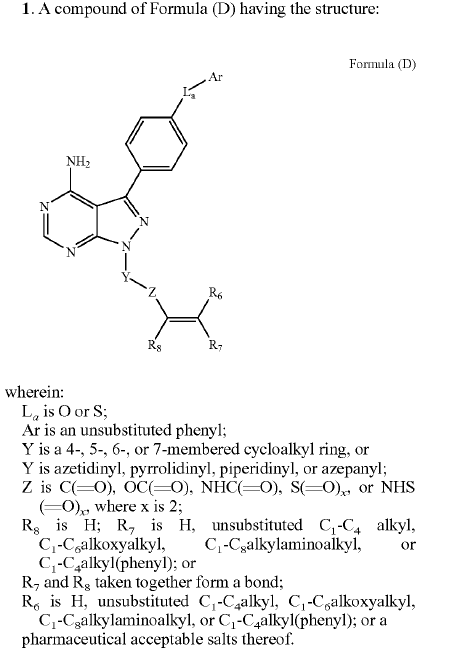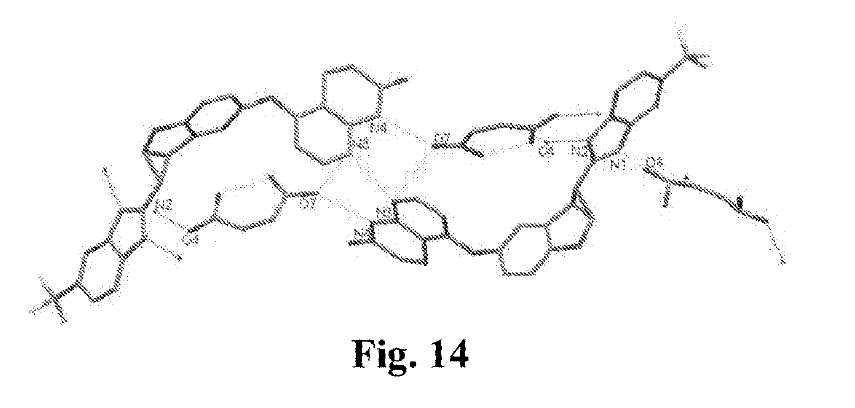“Patentees in solid-form claim drafting would do well to recognize that nature and quality of data are crucial for infringement proofs.”
 Patent claims define the boundaries of an invention and are meant to state with clarity what the patent protects. Having clearly constructed claims also proves valuable during infringement assertions. These well-known guidelines should be at the forefront of the patent practitioner’s mind when drafting solid-form claims.
Patent claims define the boundaries of an invention and are meant to state with clarity what the patent protects. Having clearly constructed claims also proves valuable during infringement assertions. These well-known guidelines should be at the forefront of the patent practitioner’s mind when drafting solid-form claims.
Claims
Patent attorneys practicing in the chemical arts use two primary methods of claiming chemical compounds. The first method relies on chemical nomenclature to describe a claimed chemical compound. Take for example, the drug Wakix® (U.S. Patent No. 7,169,928), in which the active ingredient, pitolisant, is claimed to reference its chemical name without drawing a corresponding structure. The second method claims the drawn chemical structure of a compound. Of course, there are intermediate ways to claim chemical compounds where both names and structure are used to define the scope — especially with genus and sub-genus claims. Consider claim 1 of U.S. Patent No. 7,514,444 (reproduced below), which includes both a chemical structure and language to limit the scope of the claimed invention.

Figure 1
The claim in Figure 1 provides a chemical structure framework, including a phenylene bonded to a substituted purine. The phenylene is also bonded to an La group, which, in turn, is bonded to an Ar group. Thus, the claim also relies on language to define La and all of the other variables in the structure claimed. Such claims utilize language common to organic chemists and patent attorneys alike.
The language-based, structure claiming paradigm can be more challenging in solid-form patent claims. In U.S. Patent No. 10,351,559 at Figure 14, for example, the solid-state structure of a claimed compound (reproduced below as Figure 2) is derived from single-crystal data. The data show the geometry of the molecule with angles and distances between atoms identified. This sort of geometry partially illustrates the solid-state structure of a crystal in a similar way that organic chemistry represents how atoms are bonded together in a molecule regardless if liquid, gas, or solid.

Figure 2
However, the language used to describe such a system is overly specific. Temperature fluctuations can alter single-crystal data and can thus add a hard-to-control variable. Another challenge is the difficulty in locating hydrogen atoms. Accordingly, data from analytical measurements is often relied upon as a surrogate for language to delineate claim boundaries in solid-form patent claims.
While there are many kinds of analytical methods which may be used to describe solid-form compounds — e.g., infrared spectroscopy, Raman spectroscopy, solid-state 13C-NMR spectroscopy, and differential scanning calorimetry — the most common data found solid-form in patent claims comes from x-ray powder diffraction (XRPD), in which a crystalline sample is exposed to x-ray radiation. The interaction of the x-rays with the sample results in diffracted beams, wherein their angles of diffraction are a function of the features of the crystalline structure. With sufficiently high-quality data, these features can be transformed into the kind of data seen
above in Figure 2, known as a single crystal x-ray structure. Such structures are occasionally found in patent applications, and data associated with those structures are also sometimes found in claims. However, far more frequently, one finds XRPD data which are represented in an x-y plot with twice the angle of diffraction (2?) on the x-axis and intensity of the diffraction signal on the y-axis. An example of such a plot can be found in Figure 1 of U.S. Patent No. 11,028,050 (the ‘050 patent), reproduced below as Figure 3.

Figure 3
Claim 1 of the ‘050 patent reads: “1. A crystalline form of free base Compound 1 (Form A), characterized by an x-ray powder diffraction (XRPD) pattern comprising peaks at 12.72, 15.90, 19.39, 20.80, 20.98, 23.15, and 26.08, ±0.2° 2? using Cu K? radiation.” This claim identifies the material by its chemical name, Compound 1 (as defined in the specification), and identifies the solid form as Form A. The claim includes the limitation of an XRPD with peaks which are “characteristic,” and the values of those peaks are provided along with the error or variability measurements associated with each peak.
Because solid-form claims can be so heavily dependent on the use of data, the quantity and quality of those data should be carefully considered. A useful exercise is to interrogate the solid-form data and ask how much data are necessary to describe a form, or even whether any data are necessary for such a claim. (It is also useful to consider the data variability and precision. For instance, XRPD diffraction peaks are usually recited to one signified figure past the decimal). For example, suppose one invents a new cocrystal of compound X and succinic acid. It may suffice to have an independent claim that simply reads, “A cocrystal of X and succinic acid” or even “Crystalline X: succinic acid.” In such cases, dependent claims often have solid-state data which may be used to distinguish between different polymorphs of the same compound. The ability to have solid form claims without data limitations depends on various factors including the status of the prior art. While it may be expedient to add data to such claims to advance prosecution, care should be taken as to what data to deploy. A well-known and early series of cases on polymorph patents comes from the drug Zantac®, where the active ingredient is ranitidine hydrochloride and, at the time of the case, there were two known forms of ranitidine hydrochloride, Form I and Form II.
Infringement
In one Zantac® case, Glaxo v. Novopharm, Glaxo had sued Novopharm, alleging that Novopharm’s ANDA would infringe U.S. Patent No. 4,521,431 (‘431 Patent). Glaxo, Inc. v. Novopharm, Ltd., 110 F.3d 1562. (Fed. Cir. 1997). Claim 1 of the ‘431 patent is reproduced below:
[Insert Figure 4 here]
Here, the patentees elected to rely on infrared spectroscopy to characterize the solid form. The claim states that the infrared spectrum be in mineral oil as a mull and further states the peaks that follow are “main peaks” and are characteristic. Thus, before even getting to the data, there are several claim terms that might be interesting to construe- but for purposes here, the focus shall be on the infrared data terms.
First, there are 29 independent peaks provided in the claim. At trial, Glaxo focused on the presence of a single peak—the peak at 1045cm-1—which it claimed showed evidence of infringement. However, the Federal Circuit disagreed, ruling:
[I]t is elementary patent law that all limitations are material. The single-peak analysis was thus insufficient because, as the district court correctly noted, in order to prove infringement Glaxo was required to establish the presence of each limitation of the asserted claims.
The patentees in Glaxo elected to put 29 peaks in the claim, and each is considered a limitation on the claim for an infringement proof.
Second, consider the choice of peaks: of the 29 peaks, 19 of them end in zero. Statistically, this seems unlikely. Further, peaks at high wavenumber in infrared spectra are susceptible to broadening due to oxygen-hydrogen stretches. Accordingly, broad peaks make it difficult to discern a peak maximum (peak selection) and to obtain reproducible results.
Patentees are their own lexicographers, and the patentee thus has great control over the kinds and amounts of data to put in a claim. Had there been a single 1045 cm-1 peak claim, perhaps there would have been a different outcome in Glaxo. Patentees in modern claim drafting would do well to recognize that the more data in a claim, the harder it will be to prove infringement in court — especially since the alleged infringer will be motivated to argue that infringement is not proven due to instrumental errors or variability.
Achieving Balance
Solid form claiming is a balance between language and data. In the right circumstance, data in a claim is a powerful tool for proving infringement. In the wrong circumstance, it is an unpleasant albatross hindering infringement prods. A careful assessment of the data available and the prior art informs the practitioner on the appropriate balance to strike.
Image Source: Despoit Photos
Image ID: 53536737
Author: alexmillos

![[IPWatchdog Logo]](https://ipwatchdog.com/wp-content/themes/IPWatchdog%20-%202023/assets/images/temp/logo-small@2x.png)

![[Advertisement]](https://ipwatchdog.com/wp-content/uploads/2024/04/UnitedLex-May-2-2024-sidebar-700x500-1.jpg)
![[Advertisement]](https://ipwatchdog.com/wp-content/uploads/2024/04/Artificial-Intelligence-2024-REPLAY-sidebar-700x500-corrected.jpg)
![[Advertisement]](https://ipwatchdog.com/wp-content/uploads/2024/04/Patent-Litigation-Masters-2024-sidebar-700x500-1.jpg)

![[Advertisement]](https://ipwatchdog.com/wp-content/uploads/2021/12/WEBINAR-336-x-280-px.png)
![[Advertisement]](https://ipwatchdog.com/wp-content/uploads/2021/12/2021-Patent-Practice-on-Demand-recorded-Feb-2021-336-x-280.jpg)
![[Advertisement]](https://ipwatchdog.com/wp-content/uploads/2021/12/Ad-4-The-Invent-Patent-System™.png)






Join the Discussion
No comments yet.